Saptaparna (Alstonia scholaris) Benefits, Uses, Dose, Side Effects, Remedies
Alstonia scholaris / Saptaparna is a famous bitter-astringent tasting Ayurveda herb used in skin diseases, intestinal worm infestation etc. It is named so, because its leaf occurs in a bunch of 7 whorls (7 – 10 small leaflets forming a bunch).
Botanical Name – Alstonia scholaris R.Br.
Family – APOCYANACEAE (Kutaja Kula)
Table of Contents
Aati Kashaya
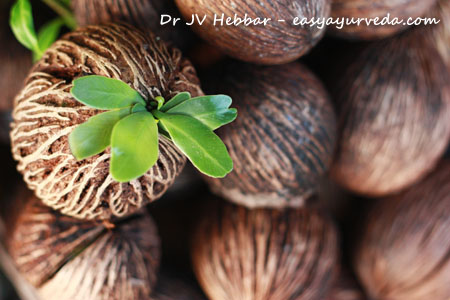
In coastal Karnataka, the bark of Saptaparna is freshly collected by using stones on the Amavasya (no moon day of Ashadha maasa – aati month) in the early morning. Its 2 tablespoons of coarse powder of bark is added to 2 cups of water, boiled and reduced to one cup, filtered. This Kashaya (herbal tea) is taken on empty stomach in the morning.
It is advised to have watery rice (Ganji / Kanji) prepared from rice with fenugreek and coconut milk on this day.
It is an excellent anti viral and antipyretic herb. From the Shravana Maasa onwards, there are numerous festivals lined up. So, people may eat lot of sweets and heavy foods which may cause indigestion.
To prepare the body and to detox the body off the ill effects of the the raining season, Saptaparna Kashaya is distributed.
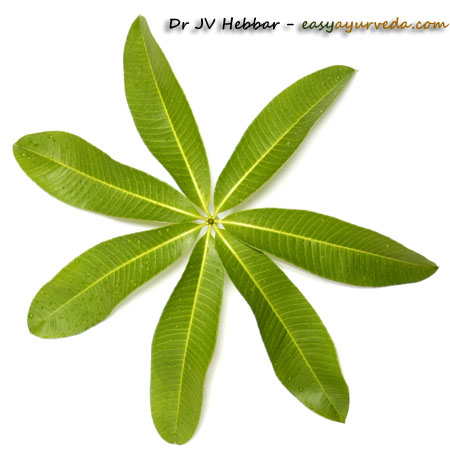
Classical Categorization
Charaka –
Kusthaghna – group of herbs used in skin diseases
Udarda prashamana – group of herbs that are used allergic skin conditions and ring worm infestation
Kashaya Skandha – group of astringent tasting herbs
Tikta Skandha – group of herbs with bitter taste
Sushruta – Aragvadhadi, Lakshadi group of herbs.
Vagbhata – Aragvadhadi group of herbs.
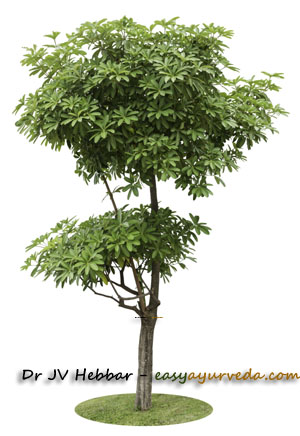
Different varieties
Alstonia macrosperma is used as its substitute.
Distribution
It is naturally found in the Sub- Himalayan tract, West Bengal, Bihar, Peninsular India and Andamans. It is also found in moderately dry places of Karnataka like Shimoga district.
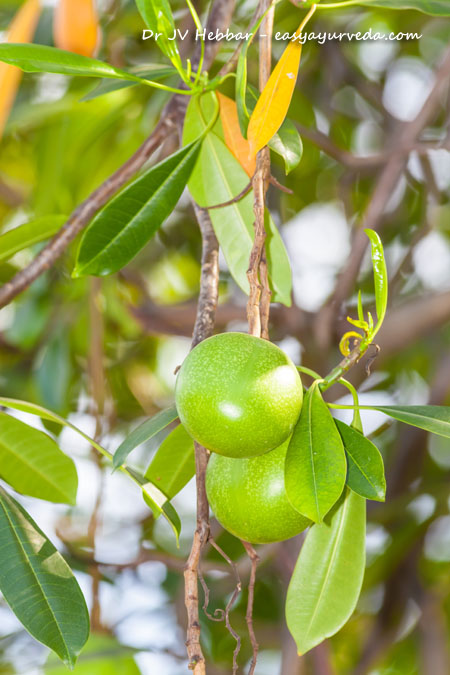
Major Chemical Constituents
Ditamine, echitenine and echitamine are used as alternatives to famous medicine – quinine. Akuammidine (rhazine); picrinine; strictamine, tetrahydroalstonine; angustilobine B, 6,7-seco-6-norangustilobine B (losbanine, alschomine, isolschomine, alstonamine; echitamine, tubotaiwine, alstonamine scholaricine etc.
(Reference: Illustrated Dravyaguna VIjnana, Vol. II, by Dr JLN Shastry)
Medicinal properties
Rasa (taste) -Tikta (bitter) , Kashaya (astringent)
Guna (qualities) -Laghu (lightness), Snigdha (unctuousness, oilyness)
Virya -Ushna – hot potency
Vipaka -Katu – undergoes pungent taste conversion after digestion.
Usually herbs with light quality have dryness (Example – Lodhra). The substances that are oily are usually heavy (hard to digest), example – sesame oil. But this is a rare herb having a combination of oiliness and lightness.
Pharmacological action – Stimulant, Carminative, Stomachic, Expectorant, Febrifuge
Effect on Tridosha
It balances all the three doshas.
Part used, dosage
Part used – Stem bark, latex, flower
Dosage – bark decoction 20 – 80 ml based on disease and patient in divided doses in a day. Powder- 1- 1.5 g
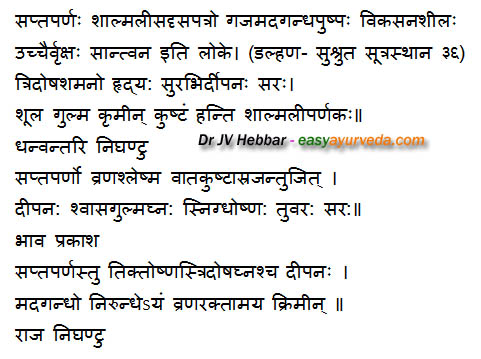
Therapeutic uses
Therapeutic uses of Alstonia scholaris –
For heart – Hrudya – acts as a cardiac tonic, good for heart, useful to relieve cholesterol deposits inside blood pipes (arteries). It also helps to lower cholesterol.
It detoxifies and cleanses blood. Hence used in a wide variety of skin diseases.
Deepana – improves digestion strength
Sara – promotes movement of content inside body channels,
Shulanut – relieves constipation, abdominal colic
Gulmanut – useful in abdominal tumor, bloating
Kruminut – useful in treating intestinal worms
Kushtam hanti – useful in skin diseases with secretions, allergic skin diseases
Vranahara – heals wound quickly
Asrahara – useful in bleeding disorders like bleeding hemorrhoids, menorrhagia
Shvasaghna – useful in asthma, COPD
It is used in the treatment of diabetes.
It increases breast milk production (lactation)
It is used in treating Vishamajwara – chronic recurrent fever.
After-delivery care – It is one of the ingredients in making Kashaya (water decoction) which is given to women after delivery. It boosts immunity and helps the new mother to avoid cold and fever.
Interaction with medicines, supplements
Can this be used while taking Homeopathic medicine?
Yes. This product does not react with homeopathic medicine.
Can this medicine be continued while taking supplements like multivitamin tablets, Omega 3 fatty acids etc?
Yes. Generally, this product goes well with most dietary supplements. However, if you are taking more than one product per day, please consult your doctor for an opinion.
With western
medicines
Seek your
doctor’s advice if you are taking this product along with other western
(allopathic / modern) medicines. Some Ayurvedic herbs can interact with modern
medicine.
If both Ayurvedic and allopathic medicines are advised together, then it is
best to take Allopathic medicine first, wait for 30 minutes and then take the
Ayurvedic medicine.
Research
Anti-diabetic and anti-hyperlipidemic activity of Saptaparna
Ayurvedic medicines
Ayurvedic medicine with Saptaparna ingredient –
Mahatiktam Kashayam – useful in sinusitis, non healing wounds
Aragwadhadi kashayam – useful in skin diseases
Maha Pacnhagavya Ghritham – useful in epilepsy, fever, piles, fistula etc.
Morphology
Tall tree, with bitter milky juice
Bark – Grey, Rough, Branches whorled
Leaves – 4- 7 whorl, dark green above and pale beneath, base is tapering, oblong lanceolate, obtuse
Inflorescence – Cymes
Flowers – Greenish white
Fruits – Follicle, cylindric, Pendulous in clusters
Seeds – flattened, with hairs at both ends, hairs are longer than the seed
Sthanika Karma (Systemic Action)
External Application – Bark paste is used externally for wound healing.
Internal administration –
Digestive system – Carminative, Amapachaka. Facilitates movement of doshas in the normal direction, Indicated in Helminthiasis, , liver disorders, colic pain, Dysentery, loss of appetite
Circulatory System – Acts as a blood purifier
Excretory system – Indicated in Diabetes
Reproductive system –Increases breast milk production in lactating mothers. Indicated in puerperal infection.
Tvak – indicated in skin diseases, urticaria etc.
Tapakrama – Indicated in fever (vishama jvara), Helps to prevent post viral complications.
Satmikarana – Indicated in body weakness after fever.
Vernacular Names
Hindi Name – Satouna, Chitvan, Chitavan
Telugu Name – Edakula Ponna, Edakulariti
English Name – Dita, Milkwood Pine, White cheesewood, Blackboard tree, Indian devil tree
Bengali Name – Chatim
Punjabi Name – Satouna
Marathi Name – Satvina, Satveena
Gujarati Name – Satvana, Saatavan
Kannada Name – Maddale
Tamil & Malayalam Name –Pala
Sanskrit synonyms
Vishala, Vishalatwak – its barks are widely spread and it is the used part of the plant.
Visamacchada – bark has uneven rough surface
Sharada – The plant flowers during Sharat Rutu (autumn))
Salmali Patraka – The leaves resemble to those of Shalmali (Bombax malabaricum),
Saptacchada – bark is the used part.
Suparnaka – leaf bunches form a beautiful design.










15 comments
dr shraddha
sir, your all articles are very good and for much extent helpful to understand ayurveda concept.
thankyou
in this article u wrote that saptparn is included in udarda prashman how it relate to gastro intestinal disorders (is udarda a GIDisorder????)
Dr J V Hebbar MD(Ayu)Author
Sorry that was a mistake. udarda refers to allergic skin conditions. I corrected it now. Thanks for pointing it out.
dr shraddha
afte reading this article i think i can use saptaparna in many disorder as was not before
Dr J V Hebbar MD(Ayu)Author
Thanks.
Dinesh Bhargava
very informative….. but this plant flowers and pollen grains causes many respiratory related problems mainly they precipitate in to asthamatic conditions… in nights it emits a fragrance that also causes disturbance psychologically may be related to term unmatta. dr.dinesh chandra bhargava cosmetic surgeon
Dr J V Hebbar MD(Ayu)Author
Dear Dr Dinesh Bhargava, Many thanks for value addition.
Mahesh Raval
Thanks for sharing detail on Saptaprna.
I would be interested to know if Plantation of Saptaprna in public places is useful. I can see huge plantation along the Highways & at many public roads in & around Thane & Mumbai.
Dr J V Hebbar MD(Ayu)Author
I do not know of its value with road side plantation.
mahesh
Hi All thanks for your valuable information.
I have an query .. I plant this Tree today only in front of my House distance is 3feet only …Is there any harm due to this?
Dr J V Hebbar MD(Ayu)Author
No harm with it. It is very auspicious.
Tejswita Parab
First photo is not of saptaparni though…
Dr J V Hebbar MD(Ayu)Author
Thanks for pointing out. Removed.
Vishal
Mere gharke samne 4 tree plaats
Lagye he
Kya use nikaldu ???
Dr J V Hebbar MD(Ayu)Author
Uska chaal ka kwath fever me use kar sakte hai. Poora plant nikaal ne ki zaroorat nahi hai.
Krishna
Sir how is it’s purification done ?